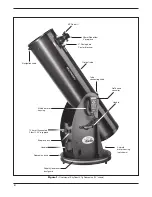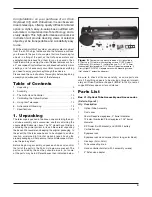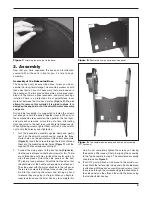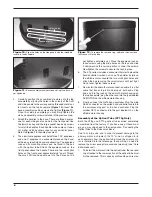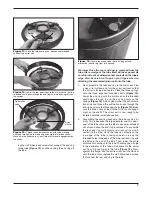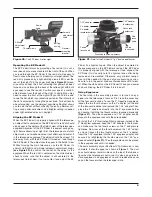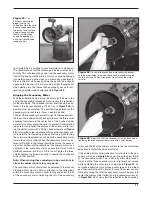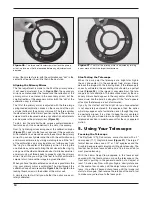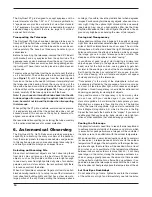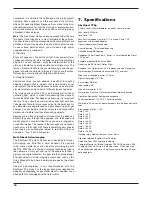
16
sometimes it is visible to the naked eye during full daylight!
Ironically, Venus appears as a thin crescent, not a full disk,
when at its peak brightness. Because it is so close to the Sun,
it never wanders too far from the morning or evening horizon.
No surface markings can be seen on Venus, which is always
shrouded in dense clouds.
Mars: The Red Planet makes a close approach to Earth every
two years. Observing Mars is most favorable at these times.
You should see a salmon-colored disk with some distinct dark
patches, and you may be able to spot a whitish polar ice cap.
To see surface detail on Mars, you will need a high power
eyepiece and very steady air!
D. The Stars
Stars will appear as tiny points of light. Even powerful tele-
scopes cannot magnify stars to appear as anything more than
pinpoints. You can, however, enjoy the different colors of the
stars and locate many pretty double and multiple stars. The
famous “Double-Double” in the constellation Lyra and the gor-
geous two-color double star Albireo in Cygnus are favorites.
Defocusing a star slightly can help bring out its color.
E. Deep Sky Objects
Under dark skies, you can observe a wealth of fascinating
deep sky objects; that is, objects that reside outside of our
solar system. These include gaseous nebulas, open and glob-
ular star clusters, and a variety of different types of galaxies.
The large aperture of the XTg is particularly well suited to
gathering light, which is critical for observing these usually
faint celestial entities. For deep sky observing it is important
that you find an observing site well away from light pollution.
Take plenty of time to let your eyes adjust to the darkness. As
you become more experienced and your observing skills get
sharper, you will be able to ferret out more and more subtle
details and structure from these fascinating objects.
Beginners are often surprised to discover that the deep sky
objects they see through the eyepiece of a telescope are
mostly grayish, not colorful like those you see in long-expo-
sure astro-images. The reason is that our eyes are not sensi-
tive to color in faint light. Still, there is something very special
about seeing an astronomical object in real time with your
own eyes – “live,” if not in living color.
note about astro-imaging
The SkyQuest XTg GoTo Dobsonian is designed for visual,
not imaging, use. With that in mind, however, it is possible
to do some simple lunar and planetary astro-imaging with
the XTg. With the use of afocal imaging techniques (where
the camera is simply put right up to the eyepiece to take a
picture) and digital cameras, it is possible to capture images
of bright objects. Certain imaging accessories, such as the
Orion SteadyPix, can help in obtaining images by the afocal
method.
Deep-sky photography is not recommended with the
SkyQyest XTg Dobs. For the longer exposures required for
deep-sky photography, an equatorial mount is needed, or an
altazimuth mount equipped with a field rotator.
7. specifications
skyQuest Xt8g
Primary mirror: 203mm diameter, parabolic, center-marked
Focal length: 1200mm
Focal ratio: f/5.9
Focuser: Dual-speed Crayford (11:1), accepts 2" and 1.25"
eyepieces with included adapter
Optical tube material: Rolled steel
Azimuth bearing: Thrust needle bearing
Altitude bearing: Ball bearing
Eyepieces: 28mm DeepView, 2" barrel, 12.5mm Illuminated Plössl,
1.25" barrel
Eyepiece magnifications: 42x and 96x
Finder scope: EZ Finder II Reflex Sight
Eyepiece rack: Holds three 1.25" eyepieces and one 2" eyepiece
Mirror coatings: Enhanced aluminum with SiO
2
overcoat
Minor axis of secondary mirror: 47.0mm
Optical tube weight: 19.7 lbs.
Base weight: 38.5 lbs.
Tube length: 46.5"
Tube outer diameter: 9.25"
Motor drives: Dual-axis GoTo computerized, internally housed
Operation: Northern or Southern hemisphere
Power requirement: 12V DC 2.1 Amp (tip positive)
Motor type: DC servo with optical encoders for altitude and azimuth
axes
Slew speeds: Rate 0 = 1.0X
Rate 1 = 2X
Rate 2 = 16X
Rate 3 = 32X
Rate 4 = 50X
Rate 5 = 200X
Rate 6 = 400X
Rate 7 = 600X
Rate 8 = 800X
Rate 9 = 1000X
Tracking rates: Sidereal (default), Lunar, Solar.
Alignment method: Brightest Star, Two-Star
Database: Over 42,900 objects including:
Complete Messier & Caldwell catalogs, 7840 NGC objects, 5386
IC objects, 29523 SAO stars, 8 planets, moon, 212 named stars,
55 well-known double stars, 20 well-known variable stars, 25 user-
defined objects.

